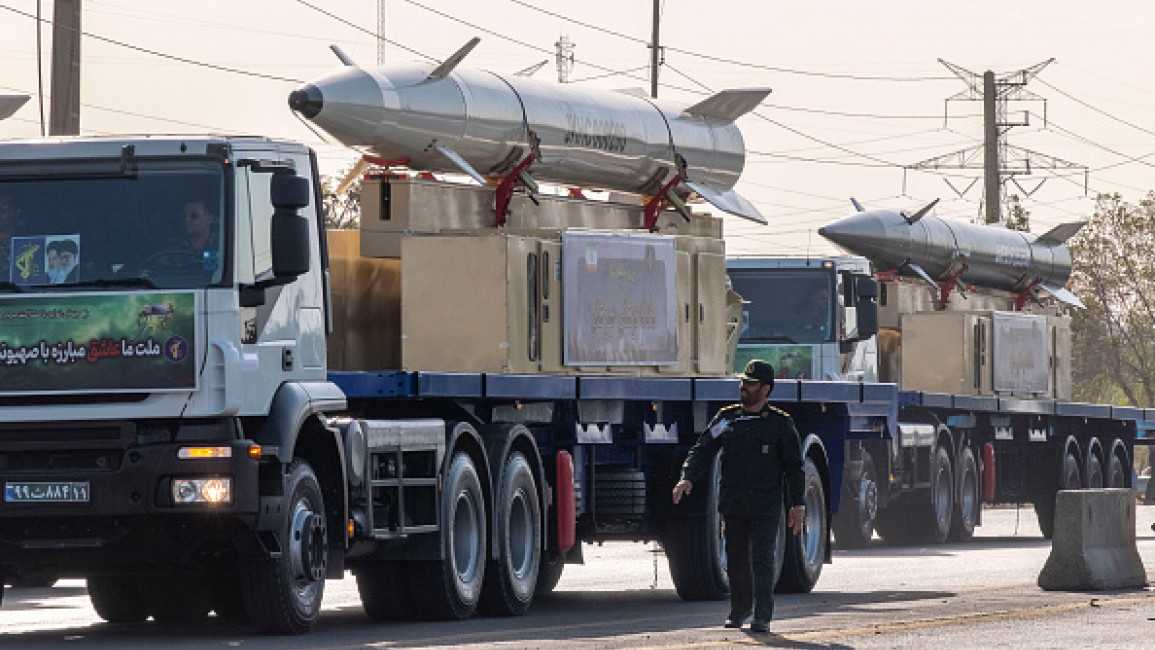What missiles did Iran use in its attack on Israel?
Iran launched its largest-ever attack on Israel on Tuesday, firing almost 200 ballistic missiles.
The attack came as retaliation for Israel’s killing of Hamas leader Ismail Haniyeh in Tehran in July and the killing of Hassan Nasrallah, the Secretary-General of the Iranian-funded Hezbollah, in Beirut last month.
Most of the Iranian missiles were intercepted by anti-missile defence systems and strategies employed by Israel, the United States and Jordan, with potential UK involvement.
The New Arab looks into the missiles likely used by Iran in the attack, the technology Israel uses to thwart such attacks and what Iran could use in the future.
What Iranian missiles were used in the attack?
According to Iranian media, three types of ballistic and so-called “hypersonic” missiles were used in the operation against Israel.
Perhaps the most notorious is the Fattah missile.
This weapon has gained much attention from the media, as its use against Israel is the first known combat use of the missile. The Fattah is a medium-range ballistic missile, reaching distances of 1.400 km, developed by the Islamic Revolutionary Guard Corps (IRGC) and unveiled in June 2023.
The missile is often referred to as “hypersonic”, meaning it travels five times the speed of sound (around 3,800 miles per hour), but technically this is true of all ballistic missiles as they take a downward trajectory from outside Earth's atmosphere towards their targets.
Among military experts, a true hypersonic missile is a more sophisticated cruise missile that can travel at hypersonic speed within the Earth’s atmosphere, making it extremely difficult to shoot down. Experts believe that the Fattah missile is unable to achieve this.
As we’ve seen from the attack on Israel, the Fattah was quite easily shot down by Israel and its allies. Despite this, the Fattah is a potentially dangerous weapon, especially if used in large volumes.
According to Morteza al-Moussawi, an expert on the Iranian military who spoke to The New Arab’s Arabic sister outlet Al-Araby Al-Jadeed, the missile contains a “manoeuvrable re-entry vehicle”. This function allows the weapon to adjust to avoid missile defences during a short time at the point of its descent toward its target.
Another missile used by Iran in the attack is the Ghadr-110 (Qadr-1), which is another medium-range ballistic missile, capable of reaching around 1,500 km. The most notable features of the Ghadr-110 are that its high speed partially liquid-fuel design means it can evade radar, and that it can be launched from mobile platforms.
In fact, the Ghadr was launched at Israel in November of 2023 by Yemen’s Houthi rebels and was intercepted by Israel while still outside the earth’s atmosphere, making this the first instance of combat in space in human history.
The last missile used by Iran in its operation against Israel was the Emad. This projectile is a liquid fuel surface-to-surface ballistic missile, a variant of Iran’s infamous Shahab-3 missile that is itself based on North Korea’s Nodong-1 missile.
Why was Israel able to shoot these missiles down?
Israel has one of the most sophisticated layered missile defence systems in the world. While much attention is given to the Iron Dome defence system, this is actually the third layer, so to speak, of Israel’s defence system, with it being used to intercept short-range rockets and artillery fire.
The main system used to intercept Iranian missiles on Tuesday is called David’s Sling, which is a joint-US-Israeli system that uses kinetic hit-to-hit stunners to intercept medium-range ballistic missiles. It can destroy targets as far as 200 miles away.
Above this layer, Israel also used its Arrow-2 and Arrow-3, both of which were developed with and are maintained by the US. These systems use fragmentation warheads to destroy incoming ballistic missiles in their descent phase, as they dive towards targets, which usually take place in the upper atmosphere of the earth.
Along with Israel’s domestic missile defence systems, it is known that Jordan’s air force intercepted Iranian missiles, while US Destroyers, deployed in the region, likely used their own interceptor systems to help the Iranian missiles.
The UK is also known to have been involved, but it has not disclosed the manner of its involvement.
What could Iran use in the future?
After the attack on Tuesday, the IRGC released a statement saying that if Israel retaliated, Iran would carry out “crushing attacks”.
This is perhaps a subtle recognition from Iran that its missile barrage did not intend to cause much damage to Israel, but the question of whether it could carry out a “crushing attack” remains.
Unless Iran is holding back on the capacity of its military technology, the answer might lie with quantity over quality. Much like Hamas was able to overwhelm Iron Dome on 7 October by launching a huge amount of projectiles, Iran could do the same to Israel’s higher layers of defence.
Iran has a stockpile of thousands of ballistic missiles and it takes great effort and hundreds of millions of dollars for Israel to shoot down ballistic missiles. Experts believe that it costs Israel around $3.5 million to shoot down one missile using its Arrow systems and around $1.5 million for Arrow’s sling.
Iran’s idea of “crushing attacks” could very well involve a hybrid attack using hundreds of ballistic missiles and its most advanced drones, seeking to overwhelm Israel’s defences.




 Follow the Middle East's top stories in English at The New Arab on Google News
Follow the Middle East's top stories in English at The New Arab on Google News
![People gathered around the rubble of destroyed houses to search for survivors [Getty]](/sites/default/files/styles/image_330x185/public/2024-11/GettyImages-2184733820.jpg?h=199d8c1f&itok=NiM1LO2f)

